
* In the 1970s, the Sikorsky company introduced a new light helicopter, the "S-76", primarily but not entirely for civil use. The S-76 proved successful, with Sikorsky then introducing a larger helicopter, the "S-92". This document provides a history and description of the S-76 and S-92. A list of illustration credits is included at the end.
* In early 1975, Sikorsky announced the development of a new commercial helicopter, originally designated the "S-74", this machine to be the first Sikorsky helicopter designed from the outset for civilian use. It was soon renamed the "S-76 Spirit", to capitalize on the American bicentennial in 1976 -- though the "Spirit" part would be dropped in a few years, since that name didn't come out right in some foreign languages.
The S-76 was based on S-70 Black Hawk technology, with a configuration somewhat along the lines of the Agusta A109 and the Bell 222 helicopters, but larger. The first of four S-76 prototypes performed its initial flight on 13 March 1977. The type received FAA certification in April 1978. Deliveries of the initial "S-76A" production version began in early 1979.
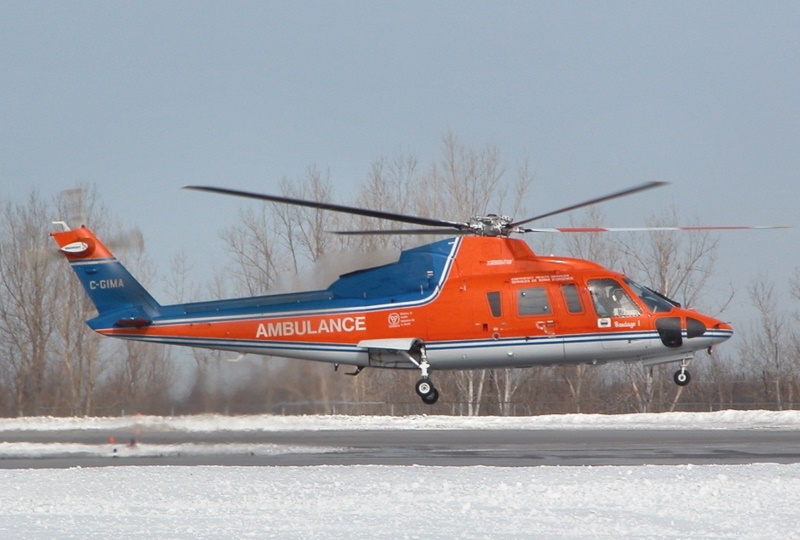
Sales of the S-76A were slow at the outset, due to the sluggish economy and various minor technical problems with the machine. The economy began to recover in the early 1980s, and Sikorsky relaunched the type in 1982 in the form of a modest production improvement designated the "S-76 Mark II", featuring an improved ventilation system, modifications to the dynamic system, and more maintenance access panels. Kits were provided to update S-76As to S-76 Mark II standard. There was also an "S-76 Utility" version of the S-76 Mark II, with a sliding door on both sides and stronger floors.
* The S-76 Mark II was a sleek machine of main-tail rotor configuration, with accommodations for one or two crew -- dual controls were optional -- and a maximum of 12 passengers, though other various passenger arrangements were available, including a four-passenger "office in the sky" layout. A wide range of luxury interiors could be installed as per customer specification. There were front-hinged doors on both sides of the cockpit, as well as doors on each side of the passenger cabin; the cabin doors were front-hinged by default, but rear-sliding doors were used on utility or search and rescue (SAR) configurations. There was a baggage hold behind the passenger cabin, with doors on each side of the fuselage. The utility version could be fitted with litters for the medical evacuation role. Avionics included radio, navigation aids, and a wide range of options, such as weather radar.
The S-76 Mark II was powered by twin Allison 250-230S turboshaft engines with a maximum continuous rating 485 kW (557 HP) each. The original S-76A used 5% less powerful Allisons. The transmission system was rated at 969 kW (1,300 HP) and could absorb the full power of both engines. The engine system included a fire detection and extinguisher system.
The S-76 Mark II used four-bladed main and tail rotors, similar to those developed for the S-70 Black Hawk, but scaled down. The main rotor had titanium spars surrounded by Nomex polymer honeycomb and sheathed with fiberglass. There were titanium-nickel abrasion strips on the leading edge of the blades, plus swept tips made of Kevlar polymer. The tail rotor was of composite construction. There was an all-moving tailplane for flight trim.
___________________________________________________________________
SIKORSKY S-76 MARK II:
___________________________________________________________________
main rotor diameter:
13.41 meters (44 feet)
tail rotor diameter:
2.44 meters (8 feet)
fuselage length:
13.22 meters (43 feet 4 inches)
footprint length:
16.0 meters (52 feet 6 inches)
height (tail rotor):
4.42 meters (14 feet 6 inches)
empty weight:
2,540 kilograms (5,600 pounds)
max sling load:
1,500 kilograms (3,300 pounds)
max loaded weight:
4,672 kilograms (10,300 pounds)
max cruise speed:
270 KPH (165 MPH / 145 KT)
service ceiling:
4,575 meters (15,000 feet)
range:
750 kilometers (465 MI / 405 NMI)
___________________________________________________________________
The S-76 Mark II had retractable tricycle landing gear, with single wheels on all gear assemblies, the nose gear retracting backwards, the main gear tucking up and back into the fuselage. The utility variant had an option for taller fixed landing gear with low-pressure tires, to provide better clearance on rough terrain -- which raised the height of the helicopter by 10 centimeters (4 inches). Other options for the S-76 included a cargo hook, rescue hoist, imaging turret under the nose, inflatable flotation bags, or engine inlet dust filters. Combined sales of the these first-generation S-76s amounted to a total of 283 machines.
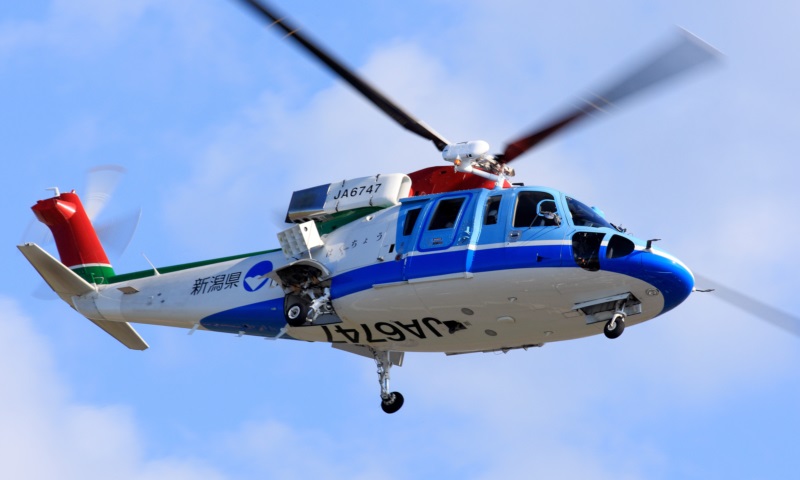
* In 1983, Sikorsky began work on the "S-76B", which was an S-76 Mark II with twin Pratt & Whitney Canada (PWC) PT6B-36 turboshaft engines with 716 kW (960 SHP) each. The power rating of the main rotor transmission system was increased to 1,118 kW (1,500 SHP). The increased power raised the maximum take-off weight by 500 kilograms (1,100 pounds).
The engine installation was of course modified, while the area of the tailfin was reduced slightly -- providing a distinguishing feature relative to earlier variants, in which the tailboom extended beyond the rear of the tailfin, this extension being eliminated in the S-76B. Otherwise, details of and options for the S-76B were much like those of the S-76 Mark II. The first prototype conducted its initial flight on 22 June 1984, leading to FAA certification in early 1987. 101 were sold through end of production in 1997.
BACK_TO_TOP* Over a dozen government services, such as the Queen's Flight in the UK and the Spanish Air Force, obtained variants of the S-76 for VIP, utility, or SAR use, but these machines had little in the way of military optimizations, except possibly military-standard radios and the like. The Philippines obtained twelve "AUH-76" militarized S-76 Mark II machines -- some of them in SAR and utility configuration, some as light attack helicopters. Details of the attack configuration are not clear, but imagery suggests they were only modest modifications of the stock S-76, featuring a stores pylon on each side of the lower fuselage for a single unguided rocket launcher pod or possibly some other store, and provision for an M60 7.62-millimeter (0.30-caliber) machine gun on a pintle mount firing out each side. There was no visible sighting system; presumably the pilot aimed the rockets with a cockpit reticle sight.
Moving along from the AUH-76, from 1985 Sikorsky promoted an "H-76 Eagle" gunship derivative of the S-76, with self-sealing fuel tanks, armored seats, provisions for door guns and a "Multi-Purpose Pylon System (MPSS)", providing weapons pylons to provide four stores attachments. Possible external stores included:
Roof or mast-mounted sights could be fitted, as well as other sensor / targeting gear and defensive countermeasures. The Eagle could be used as an armed transport, with a load of seven fully-equipped troops. For the medical evacuation role, three litters and a bench for two medical attendants could be fitted. A demonstrator was flown for several years, but nobody bit on the concept.
Sikorsky also tried to promote a navalized version of the Eagle designated the "H-76N", with an anti-shipping subvariant fitted with Ferranti Sea Spray or other targeting radar under the nose, and armament of two Sea Skua or other antishipping missiles; along with an anti-submarine subvariant with dipping sonar and two Sting Ray or similar homing torpedoes. Possible options included a roof or mast-mounted "forward looking infrared (FLIR)" imager, countermeasures gear, and a data link. There was no interest in the H-76N, and it never got beyond promotional literature.
* The S-76 has been used as an experiment and trials platform. In 1981, the US Army awarded Sikorsky with a contract to build an "S-75" demonstrator helicopter under the "Advanced Composite Airframe Program (ACAP)", which was intended to investigate the utility of lightweight composite materials in helicopter airframe construction. Sikorsky essentially took the drive system of an S-76A and put it into a composite airframe with a fair resemblance to that of the S-76, though the tricycle landing gear was non-retractable; the landing gear also featured shock absorbers to improve safety in hard landing, complementing crash-resistant seats. A static test airframe was built along with the flight demonstrator.
Initial flight of the demonstrator was in July 1984, with tests running into the spring of 1985, after which the S-75 was put into storage. The program provided a wealth of data useful to future helicopter design. The primary rationale of the S-75 effort was to support the US Army's "Light Helicopter Experimental" effort, which would evolve into the "RAH-66 Comanche" scout gunship development program.
The S-76 was used to test other elements of the Comanche. Sikorsky modified an S-76A with a one-crew cockpit grafted on to the nose to test technologies for the Comanche advanced scout helicopter, particularly improved cockpit technologies, with the work funded by the US Army. The "Sikorsky Helicopter Advanced Demonstrator of Operator Workload (SHADOW)" performed its first flight on 24 June 1985, with the machine put through various trials in different configurations for several years.
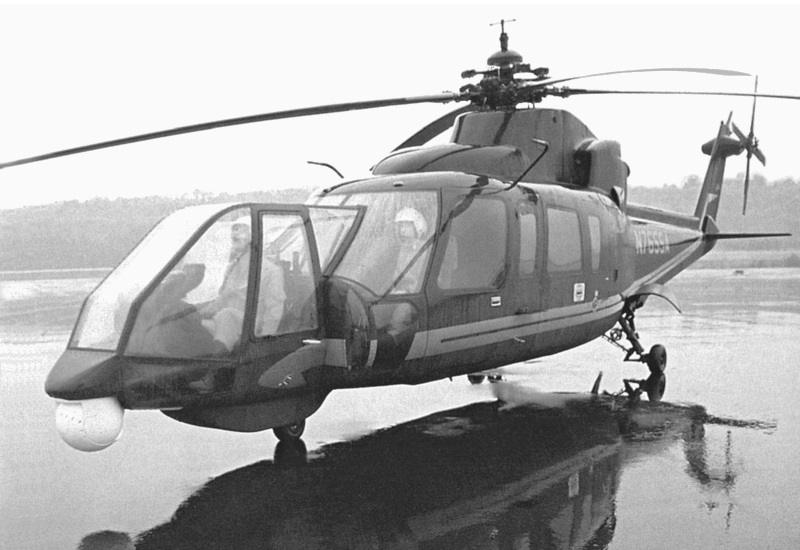
An S-76B was also configured with a "fenestron" tail or "tailfan" in place of its normal tail rotor to test that configuration for the Comanche, with this machine putting on an appearance at the Paris Air Show in 1991. The Comanche program suffered from "creeping elaboration" and changes in requirements, to be finally canceled in 2004. That led to a long-running effort by the Army to obtain a new armed scout helicopter -- which was abandoned two decades later, the realization having set in that drones were the future for the scout mission.
BACK_TO_TOP* In 1987, Sikorsky flew an S-76A with a Turbomeca Arriel 1S turboshaft engine, with a continuous rating of 525 kW (700 SHP), this variant being certificated from 1988 as the "S-76A+", available as both new production and as an upgrade, with 17 machines built new. The S-76A+ was followed by the "S-76A++", which was strictly an update program, featuring the Arriel 1S1 engine, with 540 kW (730 SHP).
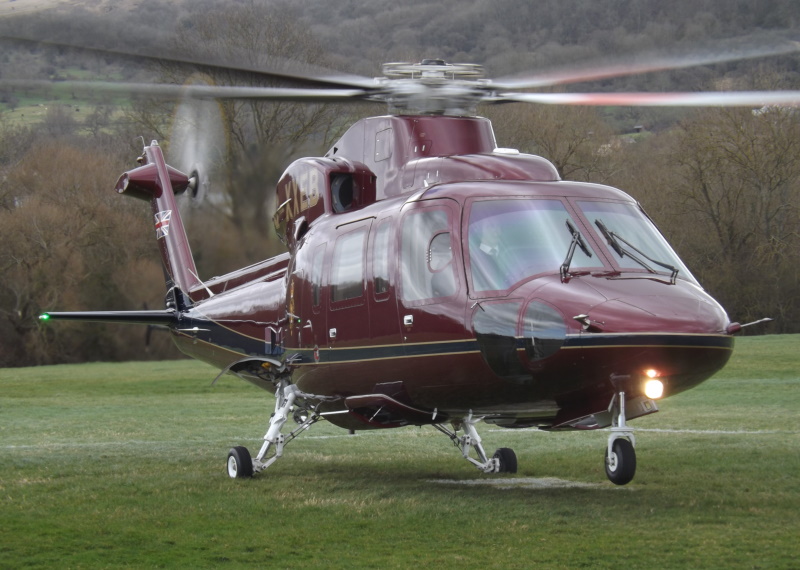
The S-76B was similarly updated with the Arriel 1S1 to produce the "S-76C". It was announced in 1989, with initial flight on 18 May 1990, and FAA certification in 1991. The "S-76C+" featured twin Arriel 2S1 turboshafts with 638 kW (856 SHP) take-off power. It was certificated in 1996.
The S-76C+ was later followed by the "S-76C++", with further uprated Arriel 2S2 engines, plus larger pop-out windows to ease emergency escape, a quiet gearbox, a Honeywell health and usage monitoring system (HUMS), and engine inlet filters. The uprated engines permitted carriage of an additional 160 kilograms (350 pounds) of payload under "hot and high" conditions. The S-76C++ was certified in late 2005.
___________________________________________________________________
SIKORSKY S-76C+:
___________________________________________________________________
main rotor diameter:
13.41 meters (44 feet)
tail rotor diameter:
2.44 meters (8 feet)
fuselage length:
13.22 meters (43 feet 4 inches)
footprint length:
16.0 meters (52 feet 6 inches)
height (tail rotor):
4.42 meters (14 feet 6 inches)
empty weight:
3,235 kilograms (7,133 pounds)
max sling load:
1,497 kilograms (3,300 pounds)
max loaded weight:
5,306 kilograms (11,700 pounds)
maximum speed:
287 KPH (178 MPH / 155 KT)
service ceiling:
3,841 meters (12,600 feet)
range:
713 kilometers (443 MI / 385 NMI)
___________________________________________________________________
These variants were stepping stones to the "S-76D", with:
The S-76D was faster than the C++, while having better fuel efficiency. Initial flight of the S-76D was on 7 February 2008, with certification in 2012, and initial deliveries in late 2013. Over 1,100 S-76 helicopters of all variants were sold, with the very last produced in 2022.
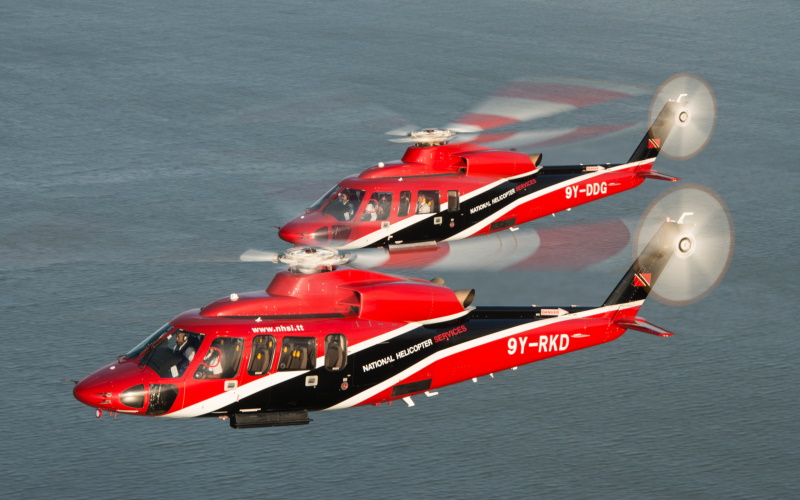
* From 2013, Sikorsky -- as of 2015, an arm of US defense giant Lockheed Martin -- worked on a "Sikorsky Autonomy Research Aircraft (SARA)", based on an S-76B. SARA was built as a testbed for an autonomous flight system, bridging the gap from a mere dumb autopilot to a robot helicopter. The primary goal of the effort, however, is to develop a helicopter with much less pilot workload, allowing the pilot to "fly the mission, not the aircraft".
SARA leveraged off research performed for the US Defense Advanced Research Projects Agency (DARPA), under the "Aircrew Labor In-Cockpit Automation System (ALIAS)" program. The company calls the autonomous flight system "MATRIX" technology. The SARA testbed was put through military evaluation from 2018, followed by civil demonstrations. At last notice, SARA was still conducting flight experiments.
BACK_TO_TOP* In 1992, Sikorsky began studies of a large transport / utility helicopter, conceived originally as the "Growth Hawk", more or less a scale-up of the S-70 Black Hawk. The design actually emerged as the "S-92 Helibus", targeted at airline transport, offshore supply, search-and-rescue, military and VIP transport. Sikorsky acquired several risk-sharing development partners including Mitsubishi Heavy Industries in Japan; Jingdezhen Helicopter Group in China; Gamesa in Spain; AIDC in Taiwan; and Embraer in Brazil.
Five prototypes were built to support the S-92 development program, the first being a nonflying ground-test article. The second prototype was the first machine to fly, on 23 December 1998. The third prototype featured significant changes, including redesign of the tail rotor configuration and addition of a 41-centimeter (16-inch) "plug" to extend the nose and improve flight trim. The final two prototypes were flying in 2001, the type being certificated by the end of that year; the first S-92A production machine was delivered in late 2004.
* The dynamic system of the S-92A was based on that of the S-70, featuring four-bladed main and tail rotors, the main rotors having drooping / tapered tips. The rotor system was rated to tolerate the impact of a 1-kilogram (2.2-pound) bird at 305 KPH (190 MPH) with no damage to the rotor. The tail rotor faced to the right, with a tailplane offset to the right underneath.
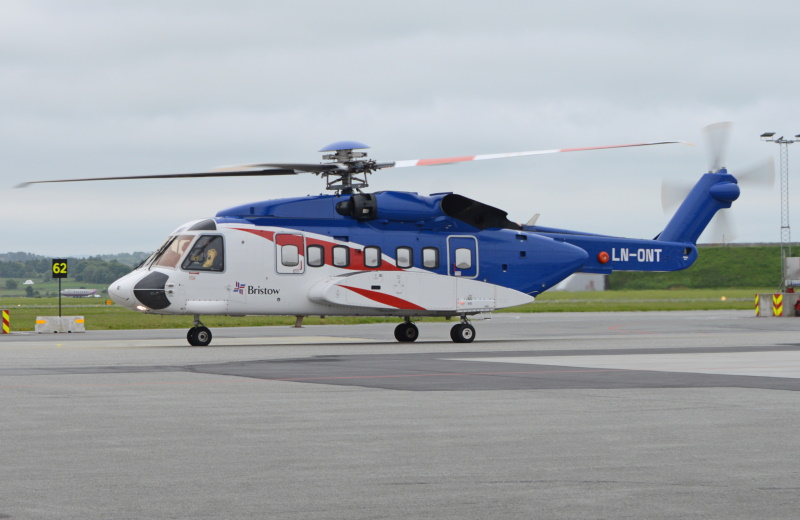
The Helibus was powered by twin GE CT7-8 (T700) turboshaft engines, with "full authority digital engine control (FADEC)" and providing 1,790 kW (2,400 HP) each at take-off. An auxiliary power unit (APU) turbine provided starting and ground power. The first and second prototypes were actually fitted with less powerful CT7-6 engines and lacked an APU. The S-92A had retractable tricycle landing gear, all gear assemblies with dual wheels, the nose gear retracting forward, the main gear retracting back into large sponsons on each side of the helicopter -- the forward part of the sponsons containing fuel tanks.
In heliliner configuration, the S-92A had 19 seats with three-across seating, and more luxurious VIP seating arrangements available as options. There was a drop-down loading ramp in the rear under the tailboom, providing access to the baggage compartment. In utility configuration, it had 22 tip-up seats along the walls of the cabin, plus floor rollers and cargo handling gear, the tail ramp providing access to the cabin for loading and unloading. A belly sling cargo hook was available as an option. Emergency medical service configurations, with a capacity of six litters, were also offered.
There was a passenger door on the right forward side of the fuselage -- usually in the form of a horizontally split door on heliliner machines, the lower half featuring an airstair, and the upper half either tipping up or sliding to the rear; or a rear-sliding door on utility and SAR machines. There was an opening window / emergency exit on the left side of the fuselage matching the door, plus similar windows / emergency exits on both sides of the rear fuselage. The cockpit side windows could pop open for crew escape.
___________________________________________________________________
SIKORSKY S-92A HELIBUS:
___________________________________________________________________
main rotor diameter:
17.71 meters (58 feet 1 inch)
tail rotor diameter:
3.35 meters (11 feet)
fuselage length:
17.32 meters (56 feet 10 inches)
footprint length:
20.85 meters (68 feet 5 inches)
height (tail rotor):
6.45 meters (21 feet 2 inches)
empty weight:
7,030 kilograms (15,500 pounds)
max loaded weight (internal load):
11,420 kilograms (25,285 pounds)
max loaded weight (with sling load):
12,020 kilograms (26,505 pounds)
maximum cruise speed:
287 KPH (178 MPH / 155 KT)
service ceiling:
4,570 meters (15,000 feet)
range:
760 kilometers (472 MI / 410 NMI)
Max loaded weight with a sling load, maximum loaded weight with
an internal load being about 600 kilograms (1,220 pounds) less.
___________________________________________________________________
The S-92A featured a "glass cockpit" with four large color flat-panel displays, provided by Rockwell Collins. The machine was designed with a strong emphasis on safety, with redundant fuel, electric, hydraulic, and control systems. The Helibus also featured an "active vibration control system", with sensors controlling actuators to damp out vibration, reducing noise and airframe stress; and a "terrain warning system" developed jointly by Sikorsky and Honeywell, since a common cause of helicopter accidents is "controlled flight into terrain". This sensor system used a 12.7 x 12.7 centimeter (5 x 5 inch) color flat panel cockpit display to provide weather or terrain data, and also provided auditory warnings under emergency conditions. Another interesting feature was a "training mode" that allowed flight under simulated "engine out / fully loaded" conditions, with instant recovery at the flip of a switch.
The S-92A was designed for maintainability, Sikorsky estimating that it only required 20% of the maintenance of the S-61 Sea King. The helicopter incorporated a "health and usage monitoring" system built by Sikorsky and BF Goodrich, and a "maintenance diagnostics" system that allowed download of maintenance data into a laptop computer, which was also loaded with a interactive maintenance manual.
A SAR configuration was on offer, which added features including:
Over 300 S-92 helicopters of all variants have been sold to date. An increased gross weight version, raising IGW by 4.5%, was introduced in 2015. While some S-92As have been obtained by commercial operators, a number of governments have obtained it as well, for the VIP, utility, or SAR roles. In late 2004, the S-92A won a SAR contract for four machines from the UK's Maritime & Coastguard Agency (MCA) as an interim capability; it was followed up by an order for seven more, to be delivered from 2014. They were actually operated by a civilian company, Bristow Helicopters, on contract with the British government. The Irish Coast Guard also obtained four S-92As for the SAR mission.
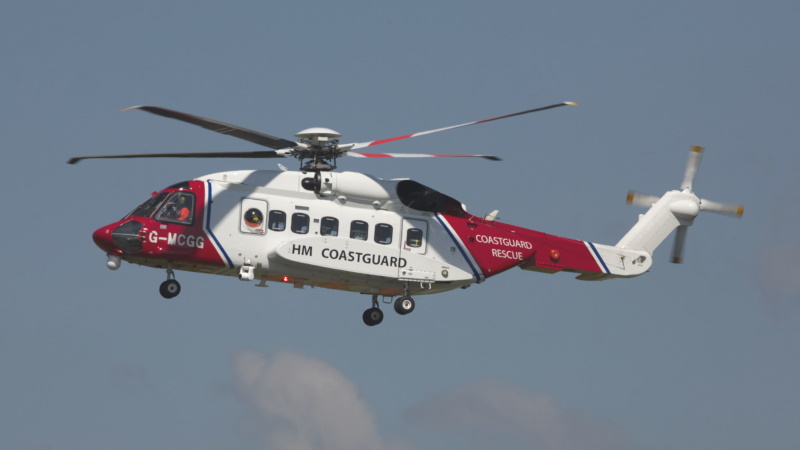
In a high-profile win, in the spring of 2014, the S-92A won the US Navy's "VXX" competition, to select the next VIP helicopter for White House service, with 23 machines to be obtained. There had actually been an earlier competition for VXX, with the AgustaWestland AW101 being selected over the S-92A, but that contract was canceled in 2009 due to cost overruns. It was dead certain the S-92A would win the second round, since nobody else bid on it, having difficulties with the specification.
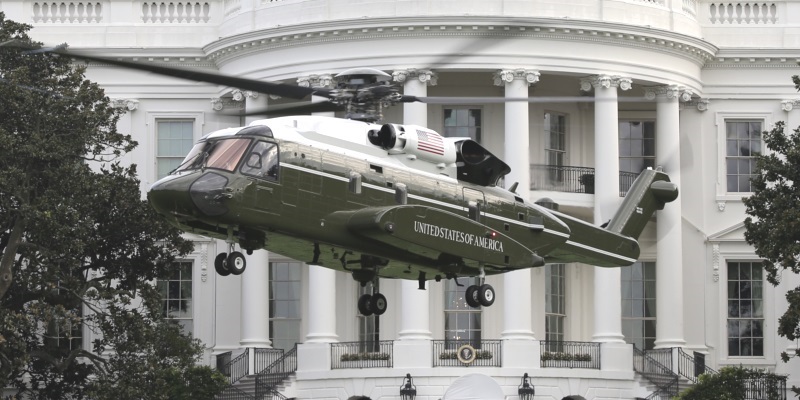
Lockheed Martin teamed up with Sikorsky on the "VH-92A", as it was formally designated, with Lockheed Martin handling the specialized mission kit required and its integration. Initial flight of the first of four test and development machines was in 2017, with two engineering development machines following. Low-rate production was authorized in 2021, with first deliveries in 2022, though full operational service didn't start until 2024. A total of 23 will be obtained -- development machines will be brought up to operational standard -- with two reserved for training. South Korea, incidentally, obtained three S-92As as VH-92As, with deliveries in 2007. They were clearly not to the same spec as the US VH-92As.
BACK_TO_TOP* Sikorsky offered a militarized version of the S-92, the "H-92 Superhawk", with customers able to choose from a menu of features:
The only win so far for the fully militarized version was in the summer of 2004, when Sikorsky was awarded the contract for the Canadian Maritime Helicopter Project to replace Canada's notoriously ancient and decrepit Sea Kings, beating the AgustaWestland AW101 on the deal. The Canadians wanted to use the H-92 in utility transport, maritime warfare, and SAR roles.
28 "CH-148" multirole machines were to be provided, with initial deliveries in 2010. For whatever reasons, the program did not go smoothly, Sikorsky being hit with penalties. It's not so clear what happened, with claims that Sikorsky failed to meet contract up against claims that the Canadians kept asking for changes.
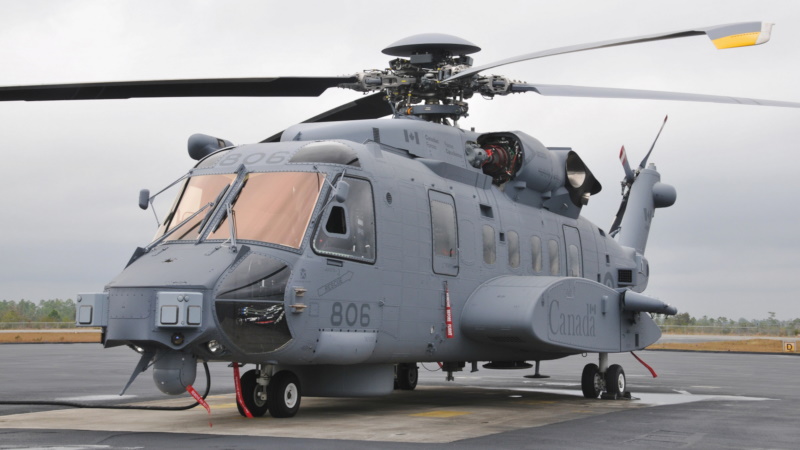
In any case, the CH-148 featured:
They had pylons outboard of the sponsons to carry munitions, it seems only qualified for homing torpedoes at the outset. It was plausible, but not reported, that they could also be fitted with pintle-mounted machine guns.
Given the CH-148's sophisticated operational kit, it's not too surprising that what was seen as an "off the shelf" helicopter at the outset turned out to be more like a machine built to custom specification. The program finally stabilized, with six interim "Block 1" machines being delivered in 2015 for training and familiarization, all of them being later updated to "Block 2" configuration. Further deliveries were in Block 2 configuration -- but there have been more delays, and by early 2025, deliveries still hadn't been completed.
In the meantime, Sikorsky developed an improved version of the S-92, the "S-92B", which featured:
S-92As could be upgraded to S-92B standard, under the designation of "S-92A+". However, the S-92B was canceled in 2023 from lack of customer interest, though the S-92A+ upgrade program continued -- if delayed to 2025.
BACK_TO_TOP* Sources include:
Most of the details were picked out of various volumes of JANE'S ALL THE WORLD'S AIRCRAFT, the online Wikipedia, and press releases.
* Illustration credits:
* Revision history:
v1.0.0 / 01 aug 13 v1.0.1 / 01 jul 15 / 7 more S-92s for UK SAR, S-92 VXX win. v1.0.2 / 01 jun 17 / Review & polish. v1.0.3 / 01 may 19 / Review & polish. v1.0.4 / 01 apr 21 / Review & polish. v1.0.5 / 01 jun 21 / Review & polish for ebook release. v1.0.6 / 01 jun 23 / Review & polish. v1.0.7 / 01 jun 25 / Review & polish.BACK_TO_TOP
